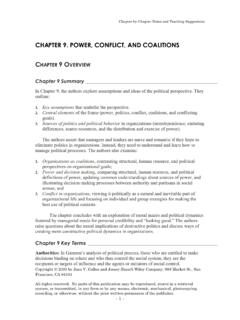Transcription of Social protection in protracted crises, humanitarian and ...
1 Social protection in protracted crises , humanitarian and fragile contexts FAO/Ivan Grifi I. FAO's agenda for action for Social protection and cash-based programmes FOOD AND AGRICULTURE ORGANIZATION OF THE UNITED NATIONS. ROME, 2016. Social protection in protracted crises , humanitarian and fragile contexts: FAO's agenda for action for Social protection and cash-based programmes In the context of the increased complexity of crises , protracted Box 1. The state of humanitarian aid displacement, overstretched capacity and the lack of resources for meeting growing humanitarian needs, development MILLION PEOPLE: The number of refugees and humanitarian actors will come together at the World and internally displaced persons due to conflict humanitarian Summit (WHS) to commit to innovative ways to at the end of 2014.
2 Effectively address these needs. MILLION PEOPLE: The number of people forced from their homes by natural disasters in 2014. The UN Secretary General's report to the WHS, One humanity: 17 YEARS: The average length of displacement. Shared responsibility, highlights the need to move beyond the 550%: The increase in the size of the UN global traditional way of doing business by broadening the scope of humanitarian appeal from $ billion in 2003 to interventions to support an effective and efficient humanitarian $ billion in 2015. response, while at the same time prioritizing investments in 40%: The shortfall in response prevention and to UN humanitarian appeals in 2014.
3 In this regard, FAO recognizes that scaling-up cash-based World humanitarian Summit Secretariat. programming and risk-informed and shock-responsive Social 2015. Restoring humanity: Synthesis of the protection systems is a strategic priority in particular to improve consultation process for the World humanitarian food security and nutrition and protect households' assets as well Summit. New York, United Nations. as increase income of the most vulnerable population. The direction: Moving towards cash-based programming and risk-informed and shock-responsive systems Over the past 15 years, there has been a rapid increase in economic activities and thus to diversify their the number of countries implementing Social protection asset base.
4 Schemes, mainly cash-based. Today, more than billion promote public work programmes to create and people in 136 countries benefit from Social assistance rehabilitate infrastructure that promotes the sustainable programmes and approximately 718 million people are use of renewable resources;. enrolled in cash transfer in the context of forced displacement, strengthen the capacity of host communities to counteract the strain on In stable but risk-prone contexts, government-run cash access to services and economic opportunities, as well transfer programmes have been integral components of as ensuring effective protection and support to refugees.
5 Poverty alleviation food insecurity of disaster risk reduction strategies. In emergency contexts, whenever markets To maximize these impacts, it is critical to build risk-informed can respond to an increase in demand, cash transfers are and shock-responsive Social protection systems that can recognized as flexible and cost-effective instruments for swiftly and effectively respond to threats and crises . Such addressing the most pressing needs of populations affected systems need to provide support ahead of a crisis and to by shocks in particular those dependent on agriculture related be based on economic and risk-related (environmental, sectors or in the rural areas.)
6 In both contexts, predictable, conflict, etc.) criteria. If they are effectively linked to early regular and sizable unconditional cash transfers can: warning systems and informed by agricultural, food security and nutritional information, Social protection systems can minimize the resort to negative coping strategies such be used to plan a timely response to emergencies. Such a as selling off productive assets, decreasing intake of response might involve increasing the amount of a transfer to nutritious foods, over-exploitation of resources, etc.; cover additional needs, temporarily expanding the number allow families to reduce their exposure to hazards: of beneficiaries receiving a transfer or complementing the cash transfers have shown their ability to enhance the transfer with other components (seed distribution, and capacity of households to invest in productive and other) to enhance the protection of assets.
7 1. Specifically, this has been recognized in the Report's call for global leaders to commit to a number of core responsibilities in the name of humanity, including to leaving no one behind and to change people's lives from delivering aid to ending need as well as in the commitments coming from the Grand Bargain, particularly around cash-based programming and minimizing the humanitarian /development divide 2. Honorati, M., Gentilini, U. & Yemtsov, R. 2015. The state of Social safety nets 2015. Washington, The World Bank. Key components of a risk-informed and shock-responsive Social protection system targets economic as well as risk-informed a contingency funding mechanism enables rapid (environmental, conflict-sensitive) factors, such as scale-up and response to unexpected transitory poor and chronically food-insecure households in emergency- food price peaks, loss of assets, etc.
8 ;. food-insecure or disaster-prone areas; comprehensive early warning systems on food provides direct transfers to households to smooth security, nutrition and climate information trigger consumption and avoid distress asset sales in the the contingency mechanism as part of a broader face of recurrent risks, such as climatic shocks or humanitarian response;. other; includes strong sub-national and community-based includes public work interventions that can structures, including the health development, Social promote sustainable agriculture by creating or development, agricultural extension and community rehabilitating infrastructures; care coalitions, etc.
9 In fragile and humanitarian contexts where Social protection Enhancing the potential of cash-based interventions structures are not in place but markets function, there has requires integrating cash in preparedness and contingency been a shift towards cash-based interventions in lieu of in- planning, strengthening partnerships with the private kind assistance. The available evidence shows the advantage sector ( financial institutions, mobile phone companies), of cash, particularly in terms of cost-effectiveness and using e-payments, digital transfers and, when possible, impact as well as flexibility and greater choice for beneficiary leveraging cash transfers to build medium and long-term households.
10 Nevertheless, in 2015, cash transfers and Social assistance structures that can be used in recurrent vouchers accounted for only six percent of humanitarian emergencies. What is the cost of inaction? Most of the time, poor, smallholder farmers are the and lives lost. hardest hit by crises : 22 percent of the damages caused Disasters and crises don't just have immediate, short- by natural hazards and disasters affect agriculture, term effects they undermine livelihoods and national and the agriculture sector absorbs 80 percent of the development gains that may have taken years to build. economic impact of Recurrent response and rehabilitation interventions are Business as usual has a cost: it means continuing more costly than prevention, insurance failure to meet critical needs in the event of a crisis and risk diversification.

















